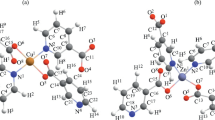Abstract
The derivatives of cyano complex compounds of iron, cobalt and nickel with bifunctional phosphonium-cations were prepared and investigated. In the case of iron and cobalt the phosphonium—hydrogen derivatives can be produced too beside those of the phosphonium-complexes. The thermal decomposition of the compounds was examined by the derivatographic method. The υCN and υNO stretching frequencies of the complexes were compared with the similar frequencies in those of the alkaline cyano complexes and their corresponding free acids. The thermal decomposition of phosphonium—hydrogen—cyanometallates leads to coordinatively unsaturated intermediates which can be prepared.
Zusammenfassung
Es wurden die Derivate von Eisen-, Kobalt- und Nickel-Cyanokomplexen mit bifunktionellen Phosphonium-Kationen dargestellt und untersucht. Bei Eisen und Kobalt sind neben Phosphonium-Komplexen auch Phosphonium—Wasserstoff-Verbindungen zu erhalten. Thermische Untersuchungen ermöglichten die Aufklärung der Zersetzungsprozesse dieser Derivate. Die vermessenen υCN- und υNO-Valenzschwingungen wurden mit denen der Alkalisalze bzw. freien Säuren verglichen. Die Thermolyse der Phosphonium—Wasserstoff-Komplexe führt zu koordinativ ungesättigten isolierbaren Zwischenstufen.
Similar content being viewed by others
Literatur
J. Brigando, Bull. Soc. chim. Fr.24, 503 (1957).
K. Friedrich undH. G. Henning, Chem. Ber.92, 2756 (1959).
L. Erdey, F. Paulik undJ. Paulik, Acta chim. Acad. Sci. Hung.10, 61 (1957).
R. H. Pierson, A. N. Fletcher undE. C. Gantz, Analyt. Chem.28, 1218 (1956).
J. P. Jesson undH. W. Thompson, Spectrochim. Acta13, 217 (1958).
R. E. Kitson undN. E. Griffith, Analyt. Chem.24, 334 (1952).
R. Heilmann undI. M. Bonnier, C. r. hebdomad. Sé. Acad. Sci.248, 2595 (1959).
M. R. Mander undH. W. Thompson, Trans. Faraday Soc.53, 1402 (1957).
G. F. Fenton, L. Hey undC. K. Ingold, J. Chem. Soc.1933, 989.
B. Mohai, Acta chim. Acad. Sci. Hung.62, 217, 229 (1969).
R. Longhi, R. O. Ragsdale undR. S. Drago, Inorg. Chem.1, 768 (1962).
L. Korecz, P. Mag, S. Papp, B. Mohai undK. Burger, Radiochem. Radioanal. Letters10 [1], 59 (1972).
V. Gutmann, Chem. in Brit.7, 102 (1971).
A. N. Garg undP. S. Goel, J. inorg. nucl. Chem.31, 697 (1969).
A. N. Garg undP. S. Goel, J. inorg. nucl. Chem.32, 1547 (1970).
D. F. Shriver undJ. Posner, J. Amer. Chem. Soc.88, 1672 (1966).
Author information
Authors and Affiliations
Additional information
Mit 1 Abbildung
Als 1. Mitt. gilt:S. Papp, S. Kovács undI. Liszi, J. inorg. nucl. Chem.34, 3111 (1972).
Rights and permissions
About this article
Cite this article
Papp, S., Dombi, A. Eisen-, Kobalt- und Nickel-Cyanokomplexe mit bifunktionellen Phosphonium-Kationen Phosphororganische Derivate von Übergangsmetall-Cyanokomplexen, 2. Mitt. Monatshefte für Chemie 104, 885–892 (1973). https://doi.org/10.1007/BF00910600
Received:
Issue Date:
DOI: https://doi.org/10.1007/BF00910600



